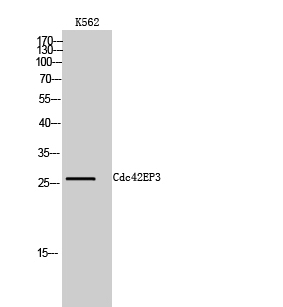产品名称
Cdc42EP3 Rabbit Polyclonal Antibody
别名
CDC42EP3; BORG2; CEP3; Cdc42 effector protein 3; Binder of Rho GTPases 2; MSE55-related Cdc42-binding protein
蛋白名称
Cdc42 effector protein 3
存储缓冲液
Liquid in PBS containing 50% glycerol, 0.5% BSA and 0.02% New type preservative N.
Human Gene Link
http://www.ncbi.nlm.nih.gov/sites/entrez?db=gene&term=10602
Human Swissprot No.
Q9UKI2
Human Swissprot Link
http://www.uniprot.org/uniprotkb/Q9UKI2/entry
Mouse Gene Link
http://www.ncbi.nlm.nih.gov/sites/entrez?db=gene&term=260409
Mouse Swissprot No.
Q9CQC5
Mouse Swissprot Link
http://www.uniprot.org/uniprot/Q9CQC5
免疫原
Synthesized peptide derived from the N-terminal region of human Cdc42EP3.
特异性
Cdc42EP3 Polyclonal Antibody detects endogenous levels of Cdc42EP3 protein.
稀释度
WB 1:500 - 1:2000. ELISA: 1:40000. Not yet tested in other applications.
宿主
Polyclonal, Rabbit,IgG
背景介绍
This gene encodes a member of a small family of guanosine triphosphate (GTP) metabolizing proteins that contain a CRIB (Cdc42, Rac interactive binding) domain. Members of this family of proteins act as effectors of CDC42 function. The encoded protein is involved in actin cytoskeleton re-organization during cell shape changes, including pseudopodia formation. A pseudogene of this gene is found on chromosome 19. Alternative splicing results in multiple transcript variants. [provided by RefSeq, Jul 2012],
组织表达
Highly expressed in the heart and weakly in the brain.
细胞定位
Endomembrane system ; Peripheral membrane protein . Cytoplasm, cytoskeleton .
功能
function:Probably involved in the organization of the actin cytoskeleton. May act downstream of CDC42 to induce actin filament assembly leading to cell shape changes. Induces pseudopodia formation in fibroblasts.,similarity:Belongs to the BORG/CEP family.,similarity:Contains 1 CRIB domain.,subunit:Interacts with RHOQ and CDC42, in a GTP-dependent manner, and with SEPT7.,tissue specificity:Highly expressed in the heart and weakly in the brain.,
纯化
The antibody was affinity-purified from rabbit antiserum by affinity-chromatography using epitope-specific immunogen.

